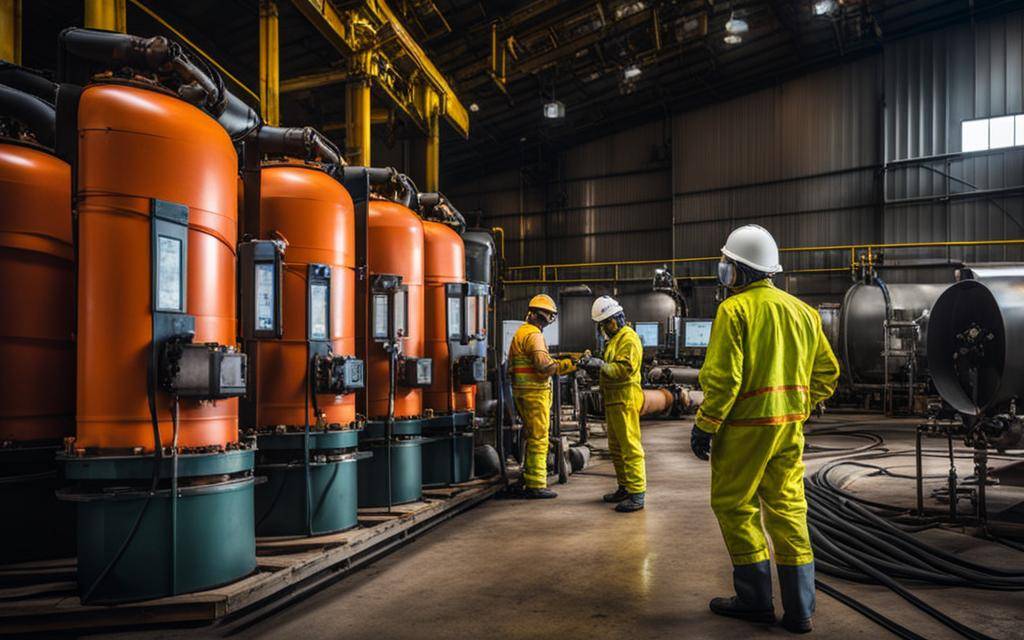Gas detection and monitoring systems are crucial in various industries to ensure safety, compliance, and prevent accidents related to gas leaks. These industries rely on 4 gas monitors to detect and monitor toxic and combustible gases, providing real-time alerts and enabling quick actions to prevent disasters. Let’s explore the industries that commonly utilize these essential safety devices.
Industries such as semiconductor manufacturing, wastewater treatment plants, oil and gas, chemical industry, and mining heavily rely on 4 gas monitors. These monitors play a vital role in detecting gases like methane, carbon monoxide, hydrogen sulfide, and oxygen levels, ensuring the well-being of workers and preventing potential hazards, especially in confined spaces.
Semiconductor Manufacturing Industries
Semiconductor manufacturing industries heavily rely on gases like methane, carbon monoxide, and phosphine in various processes. These gases are essential catalysts for reactions at the molecular level, but they are highly toxic and can pose serious health risks if not properly monitored.
Gas detection systems, integrated with existing equipment, help detect leakage and prevent catastrophic incidents. They are used in gas cabinets, wafer dryers, and reactors, ensuring the safety and well-being of workers in these environments.
Wastewater Treatment Plants
Wastewater treatment plants play a vital role in maintaining the cleanliness and sustainability of our environment. However, during the process of treating wastewater, various gases can be generated, posing potential risks to the workers and the facility. Gases like carbon monoxide, methane, and hydrogen sulfide can be released due to the decomposition of organic matter in the wastewater.
Gas detection solutions are crucial in ensuring the safety of workers and preventing potential disasters in wastewater treatment plants. These systems utilize advanced technology to detect and monitor the levels of harmful gases, especially hydrogen sulfide, in real-time.
By promptly alerting to the presence of these gases, gas detection solutions serve as a preventive measure, helping to protect workers from accidents and explosions. They also ensure a safe working environment by enabling the facility to take immediate actions in controlling and mitigating the risks associated with these gases.
Furthermore, by implementing effective gas detection solutions, wastewater treatment plants can comply with safety regulations and standards. This not only safeguards the well-being of the workers but also prevents potential environmental hazards by ensuring that harmful gases are properly managed and controlled.
Overall, gas detection solutions are an integral part of wastewater treatment plants, providing essential monitoring capabilities and safeguarding the health and safety of workers while contributing to a cleaner and safer environment for everyone.
Benefits of gas detection solutions in wastewater treatment plants:
| Benefits | Description |
|---|---|
| Worker safety | Ensures the safety of workers by detecting harmful gases and preventing accidents. |
| Prevention of explosions | By monitoring and controlling the levels of gases like methane and hydrogen sulfide, the risk of explosions is significantly reduced. |
| Regulatory compliance | Gas detection solutions help wastewater treatment plants meet safety and environmental regulations regarding the management of gases. |
| Environmental protection | By detecting and controlling gas leaks, these solutions minimize the release of harmful gases into the environment, promoting sustainability. |
Oil and Gas
The oil and gas industry is inherently complex, involving numerous processes and environments that pose significant risks to worker safety. The presence of highly combustible gases in this industry creates the potential for devastating accidents and explosions.
To prevent such incidents and prioritize safety, monitoring gas levels is of utmost importance. Gas monitoring solutions play a critical role in ensuring the control and detection of harmful gases. These systems are designed to comply with environmental regulations, minimize equipment damage, and most importantly, protect the lives of workers.
Gas monitoring solutions in the oil and gas industry are employed in various stages, from offshore exploration to onshore refining. They continuously monitor gas levels, detect leaks, and provide real-time alerts, enabling prompt actions to repair sources of leaks and prevent casualties.
By implementing gas monitoring solutions, the oil and gas industry demonstrates its commitment to workplace safety and environmental responsibility. These solutions not only safeguard the well-being of workers but also help maintain compliance with regulations and prevent the release of harmful gases into the atmosphere. This proactive approach not only saves lives but also ensures the sustainability and reputability of oil and gas operations.
Benefits of Gas Monitoring Solutions in the Oil and Gas Industry:
| Improved Safety | Enhanced Compliance | Timely Detection |
|---|---|---|
| Monitors gas levels to prevent accidents and explosions | Ensures compliance with environmental regulations | Provides real-time alerts for prompt action |
| Protects workers from exposure to toxic gases | Reduces the risk of harmful gas release | Enables quick repairs to minimize equipment damage |
| Prevents casualties and injuries | Helps maintain a safe work environment | Supports sustainability and environmental stewardship |
Chemical Industry
The chemical industry plays a vital role in manufacturing various chemicals that are used in our everyday lives. However, this industry also poses significant risks due to the release of harmful toxic gases. When inhaled, these gases can cause severe health problems for workers. Additionally, in enclosed areas, these gases can displace oxygen, leading to suffocation and difficulty in breathing.
To ensure a safe working environment, the chemical industry relies on gas detectors to detect and prevent leaks of these harmful gases during storage and transportation. Portable gas detectors are used while transporting containers to ensure immediate detection of leaks and protect workers. In industrial settings, fixed gas detectors are installed to provide continuous monitoring and timely alerts in case of any leaks.
By implementing gas detectors, the chemical industry can proactively mitigate the risks associated with harmful toxic gases, safeguard workers’ health, and prevent potential disasters.
| Harmful Gas | Effects |
|---|---|
| Ammonia | Irritates the respiratory system and can cause chemical burns |
| Chlorine | Produces respiratory irritation, lung damage, and even suffocation at high concentrations |
| Sulfuric Acid | Corrosive to the skin, eyes, and respiratory system, causing severe burns and other health issues |
| Hydrogen Cyanide | Affects the central nervous system and can lead to loss of consciousness, respiratory failure, and death |
Conclusion
Gas monitoring and detection systems are vital tools for ensuring workplace safety across various industries. By utilizing 4 gas monitors, industries can effectively prevent casualties caused by gas leaks, adhere to regulatory requirements, and maintain a safe working environment.
These advanced systems are extensively used in semiconductor manufacturing, wastewater treatment plants, oil and gas, chemical industry, and mining sectors. With their capability to provide real-time alerts and enable swift actions to mitigate risks, gas monitoring systems play a crucial role in saving lives and preventing disasters.
Continuous monitoring of gas levels is a proactive approach that helps industries prevent accidents, protect the well-being of their workers, and uphold a safer work environment. The deployment of gas monitoring and detection systems ensures that potential gas leaks and dangerous gas levels are promptly detected, enabling immediate intervention and reducing the potential for harm.

